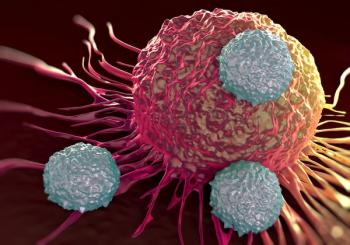
Oncology NEWS International
- Oncology NEWS International Vol 16 No 2
- Volume 16
- Issue 2
Higher Deferasirox Dose Helps Those With Insufficient Response
Patients with transfusion-related iron overload with an insufficient initial response to lower doses of deferasirox (Exjade) respond long term to higher doses
• ORLANDOPatients with transfusion-related iron overload with an insufficient initial response to lower doses of deferasirox (Exjade) respond long term to higher doses, according to data presented at the 48th Annual Meeting of the American Society of Hematology (abstract 1769). Deferasirox is a once-daily, oral iron chelator approved for the treatment of chronic iron overload due to blood transfusion in adult and pediatric patients.
John B. Porter, MD, University College Hospital, London, noted that deferasirox doses in the 1-year core phase registration trials were assigned initially based on baseline liver iron concentration (LIC). In these trials, those with low baseline LIC received relatively low doses of deferasirox, which were generally insufficient to offset the iron added from ongoing blood transfusions. In the extension phase of the trials, dose adjustments were made to achieve either iron reduction or iron balance. The current study was designed to assess deferasirox's long-term efficacy and the impact on iron burden of these dose increases.
The pooled analysis was based on two trials among subjects 2 years of age or older with transfusional iron overload requiring eight or more transfusions in the previous year and with elevated LIC. Dr. Porter reviewed results from 480 patients who entered the extension study and received at least one deferasirox dose.
In the core phase, patients with LICs of 2 to 3 mg Fe/g dw received a deferasirox dose of 5 mg/kg/d; those with LICs of greater than 3 to 7 received 10 mg; and those with LICs of greater than 7 to 14 or greater than 14 received 20 or 30 mg. Efficacy was assessed according to the change from baseline in serum ferritin.
Patient diagnoses included β-thalassemia (n = 381), myelodysplastic syndromes (n = 47), and other anemias (n = 52). Most continued on treatment in the extension phase, receiving deferasirox for a median of 2.6 years (average dose, 21.3 mg/kg/d).
Median baseline serum ferritin values in the three dose cohorts were 1,932, 2,527, and 4,158 ng/mL, respectively. During the core and extension phases, serum ferritin levels decreased in patients who received deferasirox 30 mg/kg/d and were maintained in patients who received 20 mg/kg/d. In contrast, serum ferritin steadily increased in patients who initially received 5 to 10 mg/kg/d.
The proportion of patients in the 5 to 10 mg/kg/d dose group with serum ferritin values less than 1,000 ng/mL started to increase only after the dose was escalated to more appropriate levels (between 20 and 25 mg/kg/d) in the extension phase, confirming that the lower doses were insufficient, Dr. Porter said. He added that deferasirox dose increases are also recommended in patients receiving 20 mg/kg/d who have continually elevated serum ferritin levels.
During the extension phase, while doses were reduced slightly in the group initially receiving 30 mg/kg/d, the proportion of patients with serum ferritin values less than 1,000 ng/mL continued to increase (15-fold increase from baseline to week 128).
Dr. Porter concluded: "These results highlight that deferasirox is effective for controlling excess iron levels over the long term. The regular monitoring of serum ferritin trends to evaluate treatment success, combined with ongoing transfusion requirements and the patients' therapeutic goal, will allow physicians to individually adjust the dose up or down and prescribe the most appropriate dose."
Articles in this issue
almost 19 years ago
Exemestane After 5 Years of Tamoxifen Prevents Relapsesalmost 19 years ago
BreastCancerTrials.org Empowers Patients to Find Trialsalmost 19 years ago
S-1, New Fluoropyrimidine, Increases Stomach Ca Survivalalmost 19 years ago
Aranesp Ineffective in Anemic Ca Patients Not on Chemoalmost 19 years ago
Rituximab/CHOP Significantly Improves Outcomes in Advanced FLalmost 19 years ago
Embryonic Stem Cell Vaccines Effective in Micealmost 19 years ago
Fewer Cancer Deaths 'No Fluke'Newsletter
Stay up to date on recent advances in the multidisciplinary approach to cancer.
































































































